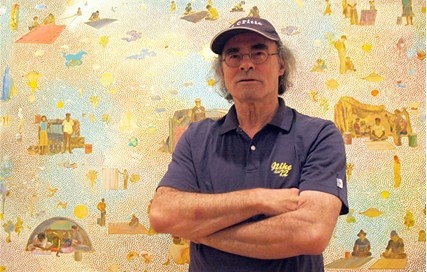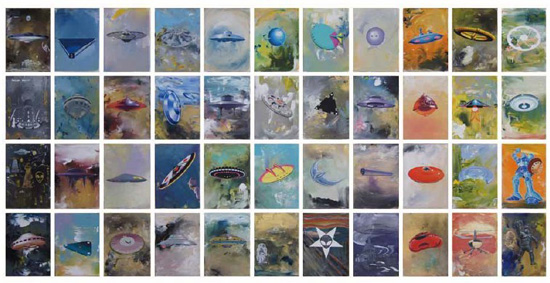|
Introduction of the artist:

Tim JOHNSON(Australia)
Born in 1947, Sydney, Australia. Lives and
works in Sydney.
Selected
solo exhibitions: 2010 Emulation, Dominik Mersch Gallery, Sydney; 2009 Painting
Ideas, Art Gallery of N.S.W. Queensland Art Gallery, Brisbane, Australia; 2003
Karyn Lovegrove Gallery, Los Angeles; 2001 Lord Mori Gallery, Los Angeles; 1994
Glasgow Museum, UK; 1988 Richard Pomeroy Gallery, London; 1971 Nova Scotia
College of Art, Halifax, Canada; 1970 Off the Wall, Gallery A, Sydney;
Selected group exhibitions: 2012 18th Biennale of Sydney; 2008 Open Air:
Portraits in the Landscape, National Portrait Gallery, Canberra, Australia; 2000
Flight Patterns, MOCA, Los Angeles; 1994 Antipodean Currents, Guggenheim Museum,
New York; 1992 Documenta 9, Kassel, Germany.
Tim Johnson is primarily concerned with the communication of unseen
phenomena, visionary in his apprehension of spiritual dimensions through
artistic practice. His style of painting is eclectic in the extreme,owing much
to Australian aboriginal traditions of the Central Desert – developed to convey
narratives in landscape that are invisible to the uninitiated – and populated by
the Buddha, Bodhisattvas, Native Americans as well as aboriginal figures,
Tibetan monks, Vietnamese farmers, extra-terrestrials and Christian worthies.
They co-exist in fields of dots and circles, or float across shimmering colour,
to exemplify a fundamental understanding that is at once humanist and
conceptual.
Introduction of works:

Tim Johnson and Nava Chapman, Indivisible Painting (10 panels), acrylic on
linen, 183×60 cm each, 2012, courtesy: Milani Gallery and Tolarno Galleries

Tim Johnson and Daniel Bogunovic, UFOs per se (44 small canvases), acrylic on
canvas, 20.3×15.2 cm, 2008-2012, photo courtesy: Dominik Mersch gallery
Tim Johnson is primarily concerned with the communication of unseen
phenomena, visionary in his apprehension of spiritual dimensions through
artistic practice. His style of painting is eclectic in the extreme, owing much
to Australian aboriginal traditions of the Central Desert - developed to convey
narratives in landscape that are invisible to the uninitiated – and populated by
the Buddha, Bodhisattvas, Native Americans as well as aboriginal figures,
Tibetan monks, Vietnamese farmers, extra-terrestrials and Christian worthies.
They co-exist in fields of dots and circles, or float across shimmering colour,
to exemplify a fundamental proposition that is at once humanist and
conceptual.
Concerning the diversity of cultural influences on his work, Johnson
explains, “Like a poem, every part doesn’t have to be logical or located in the
same time-space continuum. A painting can create a fragmented reality that is
interpreted by the viewer. Everyone sees things differently anyway. I create a
collage of imagery in the work – fragmented like life itself.” This is
concomitant with an enthusiasm for artistic collaboration, whereby he often
invites others to contribute directly to his canvases. They might be members of
his family, Australian aboriginal
painters such as Turkey Tolson Tjupurrula
or Clifford Possum Tjapaltjarri, or the American-based artist Daniel Bogunovic
who specialises in flying saucers and cartoon characters.
| 
